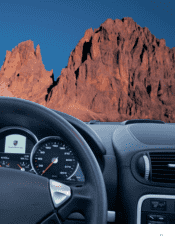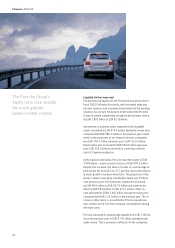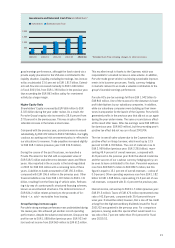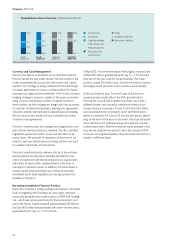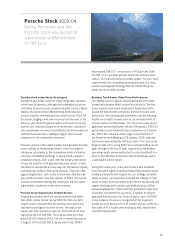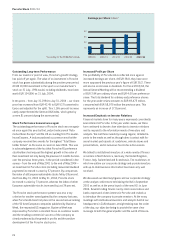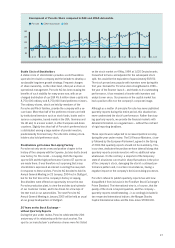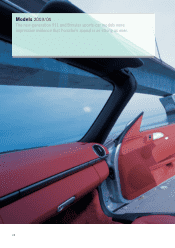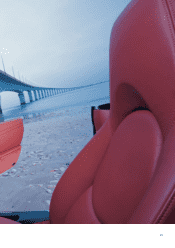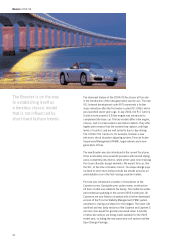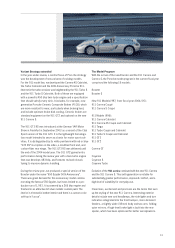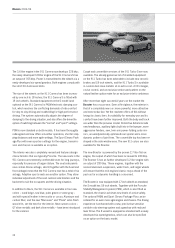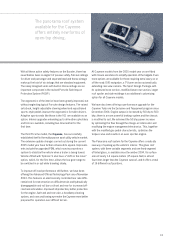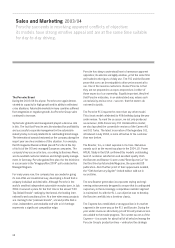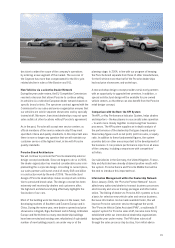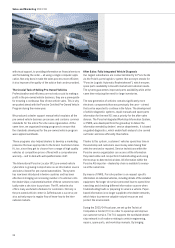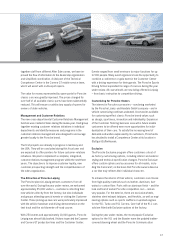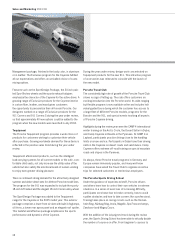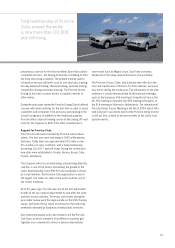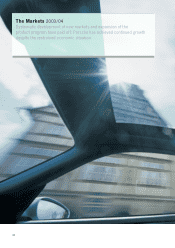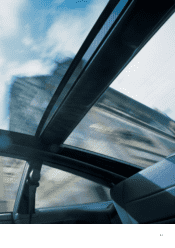Porsche 2003 Annual Report Download - page 35
Download and view the complete annual report
Please find page 35 of the 2003 Porsche annual report below. You can navigate through the pages in the report by either clicking on the pages listed below, or by using the keyword search tool below to find specific information within the annual report.
31
Variant Strategy extended
In the year under review, a central focus of Porsche strategy
was the development of new variants of existing models.
For the 911 model line, we developed the Carrera 4S Cabriolet,
the Turbo Cabriolet and the 40th Anniversary Porsche 911.
Interest in the turbo versions was heightened by the 911 Turbo S
and the 911 Turbo S Cabriolet. Both of these are equipped
with a powerful 450 bhp twin-turbo engine and a specification
that should satisfy every wish. It includes, for example, new-
generation Porsche Ceramic Composite Brakes (PCCB), which
are more resistant to wear, particularly when braking hard,
and include optimum brake disk cooling. Ceramic brakes are
standard equipment on the 911 GT2 and optional on the new
911 Carrera S.
The 911 GT3 RS was introduced at the German ‘IAA’ Motor
Show in Frankfurt in September 2003 as a variant of the Club
Sport version of the 911 GT3. It is the lightweight homologa-
tion model intended to serve as a basis for motor sport acti-
vities. It is distinguished by its white paintwork with red or blue
“GT3 RS” inscription on the sides, a modified front end, and
carbon-fiber rear wings. The 911 GT3 RS was delivered until
the end of the 2004 model year. The 911 GT2 gained extra
performance during the review year with a twin-turbo engine
that now develops 483 bhp, and features revised chassis
tuning to improve dynamic handling.
During the review year, we produced a special version of the
Boxster under the name “550 Spyder 50th Anniversary”.
There was great demand for this anniversary model comme-
morating the famous 550 Spyder, but it was limited to a pro-
duction run of 1,953. It is powered by a 266 bhp engine and
finished in an attractive GT silver metallic custom paint. The
interior is trimmed in leather interior and there is a custom-color
soft top in “cocoa”.
The Model Program
With the arrival of the new Boxster and the 911 Carrera and
Carrera S, the Porsche model program in the current fiscal year
comprised the following 15 models:
Boxster
Boxster S
New 911 Models (997, from fiscal year 2004/05):
911 Carrera Coupé
911 Carrera S Coupé
911 Models (996):
911 Carrera Cabriolet
911 Carrera 4S Coupé and Cabriolet
911 Targa
911 Turbo Coupé and Cabriolet
911 Turbo S Coupé and Cabriolet
911 GT3
911 GT2
Carrera GT
Cayenne
Cayenne S
Cayenne Turbo
Evolution of the 911 series continued with the new 911 Carrera
and the 911 Carrera S. This sixth generation is notable for
substantially greater performance, improved comfort, and a
high level of suitability for everyday use.
Clean lines, excitement and precision are the terms that sum
up the styling of the new 911 Carrera. Interesting exterior
details include new oval headlamps, the side lights and turn
indicators integrated into the front bumper, more dominant
fenders, a slightly wider (38 mm) body and two-arm, folding
outer mirrors. A high-level brake light is built into the rear
spoiler, which has been optimized for better aerodynamics.


